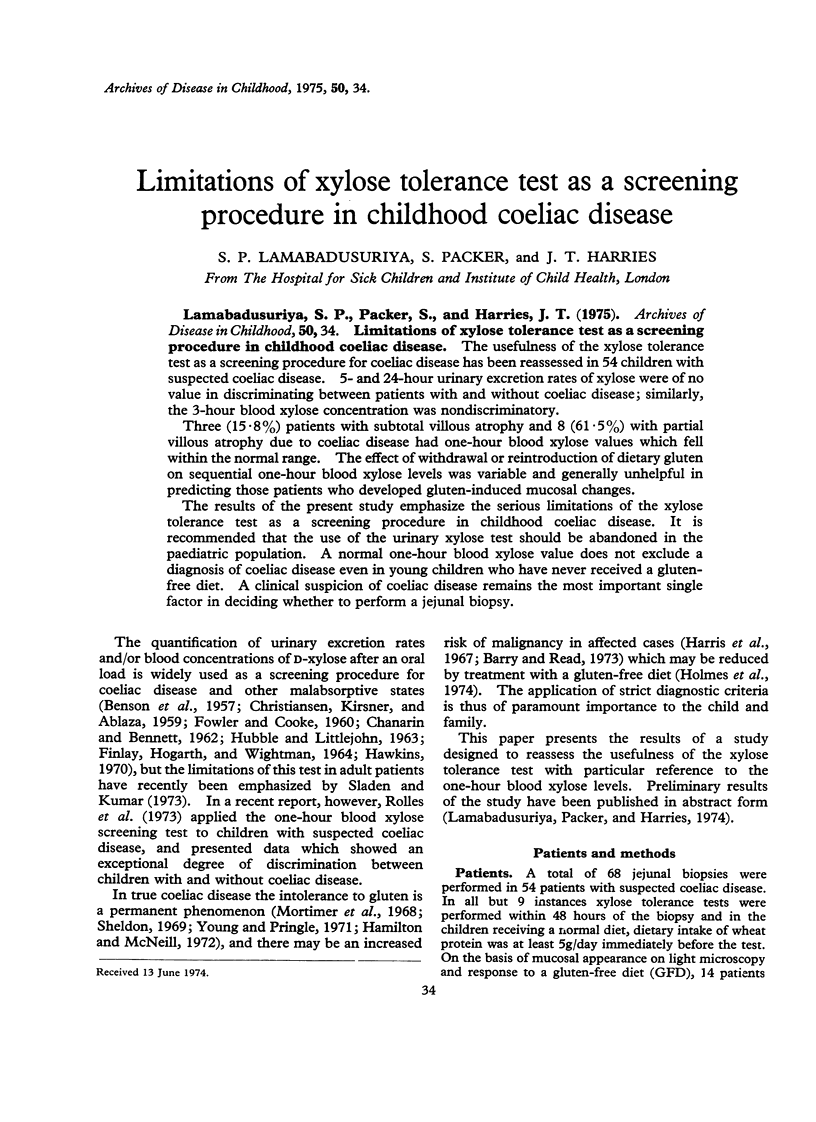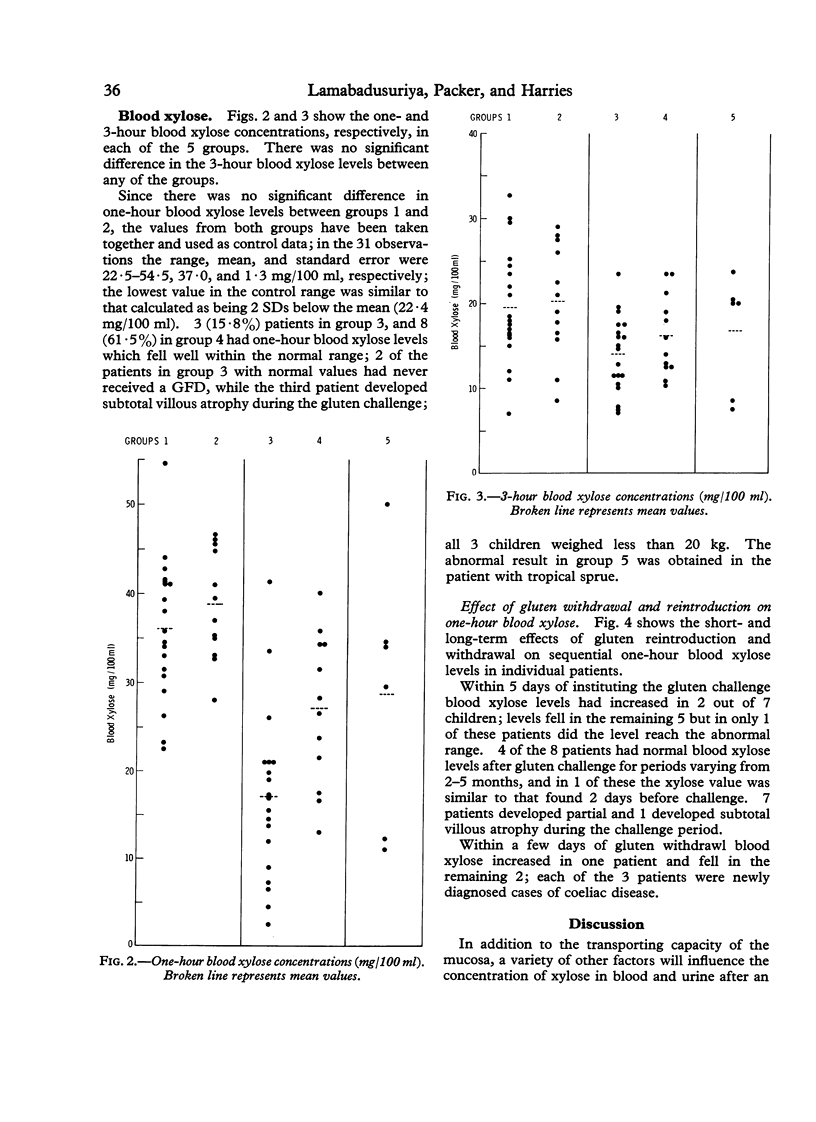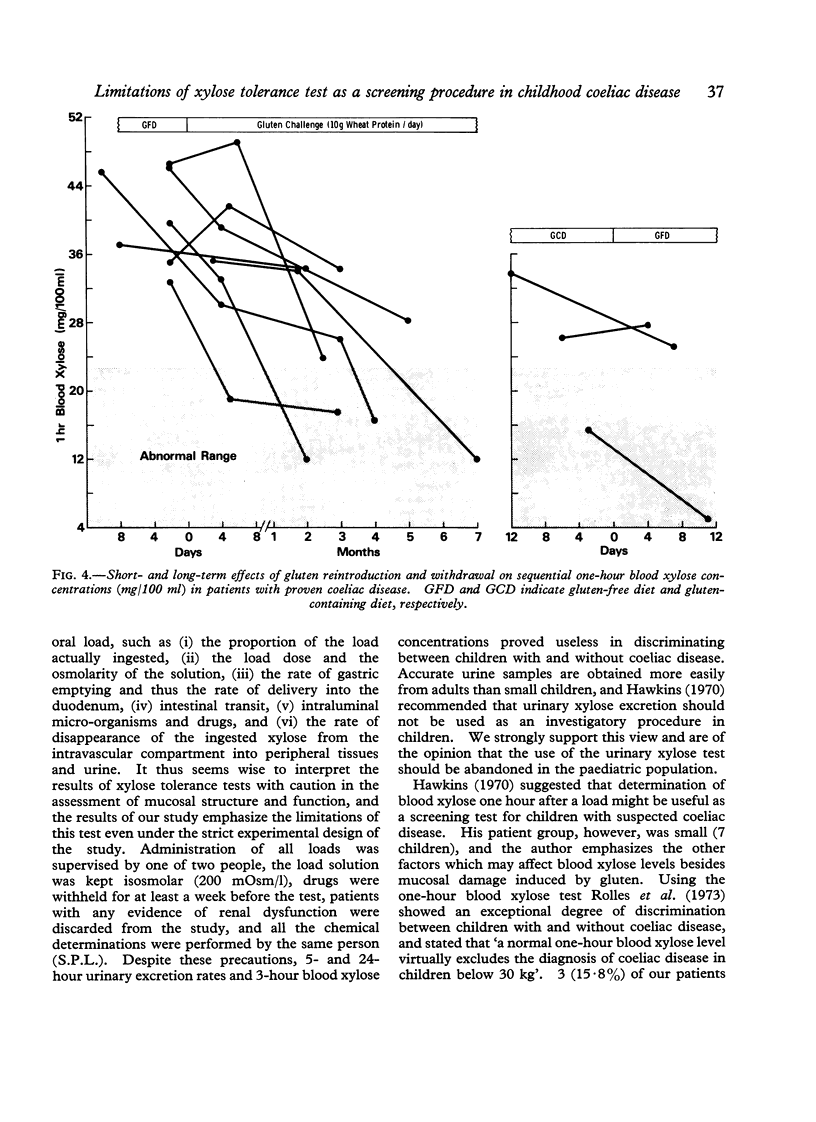Abstract
The usefulness of the xylose tolerance test as a screening procedure for coeliac disease has been reassessed in 54 children with suspected coeliac disease. 5- and 24-hour urinary excretion rates of xylose were of no value in discriminating between patients with and without coeliac disease; similarly, the 3-hour blood xylose concentration was nondiscriminatory. Three (15-8%) patients with subtotal villous atrophy and 8 (61-5%) with partial villous atrophy due to coeliac disease had one-hour blood xylose values which fell within the normal range. The effect of withdrawal or reintroduction of dietary gluten on sequential one-hour blood xylose levels was variable and generally unhelpful in predicting those patients who developed gluten-induced mucosal changes. The results of the present study emphasize the serious limitations of the xylose tolerance test as a screening procedure in childhood coeliac disease. It is recommended that the use of the urinary xylose test should be abandoned in the paediatric population. A normal one-hour blood xylose value does not exclude a diagnosis of coeliac disease even in young children who have never received a gluten-free diet. A clinical suspicion of coeliac disease remains the most important single factor in deciding whether to preform a jejunal biopsy.
Full text
PDF





Selected References
These references are in PubMed. This may not be the complete list of references from this article.
- BENSON J. A., Jr, CULVER P. J., RAGLAND S., JONES C. M., DRUMMEY G. D., BOUGAS E. The d-xylose absorption test in malabsorption syndromes. N Engl J Med. 1957 Feb 21;256(8):335–339. doi: 10.1056/NEJM195702212560802. [DOI] [PubMed] [Google Scholar]
- Barry R. E., Read A. E. Coeliac disease and malignancy. Q J Med. 1973 Oct;42(168):665–675. [PubMed] [Google Scholar]
- CHANARIN I., BENNETT M. C. Absorption of folic acid and D-xylose as tests of small-intestinal function. Br Med J. 1962 Apr 7;1(5283):985–989. doi: 10.1136/bmj.1.5283.985. [DOI] [PMC free article] [PubMed] [Google Scholar]
- CHRISTIANSEN P. A., KIRSNER J. B., ABLAZA J. D-Xylose and its use in the diagnosis of malabsorptive states. Am J Med. 1959 Sep;27:443–453. doi: 10.1016/0002-9343(59)90010-5. [DOI] [PubMed] [Google Scholar]
- Elias E., Gibson G. J., Greenwood L. F., Hunt J. N., Tripp J. H. The slowing of gastric emptying by monosaccharides and disaccharides in test meals. J Physiol. 1968 Feb;194(2):317–326. doi: 10.1113/jphysiol.1968.sp008410. [DOI] [PMC free article] [PubMed] [Google Scholar]
- FINLAY J. M., HOGARTH J., WIGHTMAN K. J. A CLINICAL EVALUATION OF THE D-XYLOSE TOLERANCE TEST. Ann Intern Med. 1964 Sep;61:411–422. doi: 10.7326/0003-4819-61-3-411. [DOI] [PubMed] [Google Scholar]
- FOWLER D., COOKE W. T. Diagnostic significance of d-xylose excretion test. Gut. 1960 Mar;1:67–70. doi: 10.1136/gut.1.1.67. [DOI] [PMC free article] [PubMed] [Google Scholar]
- HUBBLE D., LITTLEJOHN S. THE D-XYLOSE EXCRETION TEST IN COELIAC DISEASE IN CHILDHOOD. Arch Dis Child. 1963 Oct;38:476–480. doi: 10.1136/adc.38.201.476. [DOI] [PMC free article] [PubMed] [Google Scholar]
- Hamilton J. R., McNeill L. K. Childhood celiac disease: response of treated patients to a small uniform daily dose of wheat gluten. J Pediatr. 1972 Nov;81(5):885–893. doi: 10.1016/s0022-3476(72)80538-9. [DOI] [PubMed] [Google Scholar]
- Harris O. D., Cooke W. T., Thompson H., Waterhouse J. A. Malignancy in adult coeliac disease and idiopathic steatorrhoea. Am J Med. 1967 Jun;42(6):899–912. doi: 10.1016/0002-9343(67)90071-x. [DOI] [PubMed] [Google Scholar]
- Hawkins K. I. Pediatric xylose absorption test: measurements in blood preferable to measurements in urine. Clin Chem. 1970 Sep;16(9):749–752. [PubMed] [Google Scholar]
- Holmes G. K., Stokes P. L., McWalter R., Waterhouse J. A., Cooke W. T. Proceedings: Coeliac disease, malignancy, and gluten-free diet. Gut. 1974 Apr;15(4):339–339. [PubMed] [Google Scholar]
- Hunt J. N., Pathak J. D. The osmotic effects of some simple molecules and ions on gastric emptying. J Physiol. 1960 Dec;154(2):254–269. doi: 10.1113/jphysiol.1960.sp006577. [DOI] [PMC free article] [PubMed] [Google Scholar]
- Kendall M. J., Nutter S., Hawkins C. F. Xylose test: effect of aspirin and indomethacin. Br Med J. 1971 Mar 6;1(5748):533–536. doi: 10.1136/bmj.1.5748.533. [DOI] [PMC free article] [PubMed] [Google Scholar]
- Lamabadusuriya S. P., Packer S., Harries J. T. Proceedings: Limitations of xylose tolerance test as screening procedure for coeliac disease. Arch Dis Child. 1974 Mar;49(3):244–245. doi: 10.1136/adc.49.3.244-b. [DOI] [PMC free article] [PubMed] [Google Scholar]
- Rolles C. J., Nutter S., Kendall M. J., Anderson C. M. One-hour blood-xylose screening-test for coeliac disease in infants and young children. Lancet. 1973 Nov 10;2(7837):1043–1045. doi: 10.1016/s0140-6736(73)92656-1. [DOI] [PubMed] [Google Scholar]
- Sheldon W. Prognosis in early adult life of coeliac children treated with a gluten-free diet. Br Med J. 1969 May 17;2(5654):401–404. doi: 10.1136/bmj.2.5654.401. [DOI] [PMC free article] [PubMed] [Google Scholar]
- Sladen G. E., Kumar P. J. Is the xylose test still a worth-while investigation? Br Med J. 1973 Jul 28;3(5873):223–226. doi: 10.1136/bmj.3.5873.223. [DOI] [PMC free article] [PubMed] [Google Scholar]
- Young W. F., Pringle E. M. 110 children with coeliac disease, 1950-1969. Arch Dis Child. 1971 Aug;46(248):421–436. doi: 10.1136/adc.46.248.421. [DOI] [PMC free article] [PubMed] [Google Scholar]


